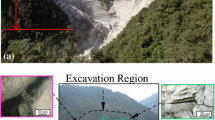Abstract
This paper presents a safety analysis study of the left bank excavation slopes of the Baihetan arch dam foundation, using a complex discrete element model developed with the 3DEC software. The Baihetan hydroelectric project is currently under construction in southwest China and consists of a 289-m-high arch dam, two underground powerhouse caverns, located in each bank, and several underground tunnels. It will be the second largest hydroelectric project in China and in the world after the Three Gorges project, reaching a total power capacity of 16 GW. The actual excavation geometry of the left bank was represented in the model using a set of ordinary photographs taken at the site. The main geological structures found in the left bank during the geotechnical surveys, and the excavations were also inserted in the model. The unfavourable configuration of the geological structures in the left bank can lead to the development of potential failure mechanisms in the rock mass that may affect the stability of the dam foundation. The safety evaluation analysis was performed by the progressive reduction of the shear strength parameters of rock discontinuities, until the failure condition is reached. This study revealed the development of local failure mechanisms in the rock mass, in the downstream excavation slopes, involving large sub-vertical faults and sub-horizontal shear bands. A parametric analysis was also performed to evaluate the effect of the variation of cohesion and friction angle values of the sub-horizontal shear band involved in one of the failure mechanisms identified. This study confirmed the need in continue monitoring the downstream excavation slopes, since some rock block instabilities have already been detected during excavations.

Source: www.internationalrivers.org, 2012
















Similar content being viewed by others
References
Alonso E, Gens A, Carol I, Prat P, Herrero E (1994) Three-dimensional failure mechanisms in arch dam abutments—A safety study. In: Proceedings of 18th ICOLD congress, Durban, vol. 1, pp. 471–484
Autodesk (2016) 123D Catch, Autodesk Inc
Cui J, Jiang Q, Feng XT, Li S, Liu J, Chen W, Zhang J, Pei S (2017) Insights into statistical structural characteristics and deformation properties of columnar jointed basalts: field investigation in the Baihetan dam base, China. Bulletin of Engineering Geology and the Environment (https://doi.org/10.1007/s10064-017-1029-0)
Detournay C, Meng G, Cundall P (2016) Development of a constitutive model for columnar basalt. In Proceedings of the 4th Itasca symposium on applied numerical modeling, Lima, Peru, pp. 249–265
Espada M, Muralha J, Lemos JV (2015) Foz Tua hydroelectric powerscheme—Update of the safety assessment study for foundation failure scenarios. Internal Report. LNEC, Lisbon (in Portuguese)
Farinha MLB, Lemos JV, Maranha das Neves E (2012) Analysis of foundation sliding of an arch dam considering the hydromechanical behavior. Front Struct Civ Eng 6:35–43
Feng XT, Hudson J (2011) Rock engineering design. CRC Press, Boca Raton
Hu L, Zhai E, Fan Y, Li S (2016) Baihetan dam—China: rock mechanics control of columnar-jointed basalt. In: ICOLD-CIGB int symposium, Johannesburg, pp 2b-283–2b-289
ITASCA (2013) 3DEC, Version 5.0, User’s Guide. Itasca Consulting Group, Minneapolis, USA
Jiang Q, Feng XT, Chen J, Huang K, Jiang YL (2013) Estimating in situ stress from spalling veins: a case study. Eng Geol 152:38–47
Jiang Q, Feng XT, Hatzor YH, Hao XJ, Li SJ (2014) Mechanical anisotropy of columnar jointed basalts: an example from the Baihetan hydropower station, China. Eng Geol 175:35–45
Lemos JV (2011) Discontinuum models for dam foundation failure analysis. In: Proceedings of 12th ISRM congress, Beijing, pp 91–98
Lemos JV (2012) Modelling the failure modes of dams’ rock foundations. Chapter 14 of MIR 2012—Nuovi metodi di indagine, monitoraggio e modellazione degli amassi rocciosi (Ed. G. Barla), Politecnico di Torino, pp 259–278
Londe P (1973) Analysis of the stability of rock slopes. Q JI Eng Geol 6(3):93–127
Meng GT, Zhu HC, Wu GY, Shi AC, Cornet FH (2010) Interpretation of in situ stress at Baihetan project. American Rock Mechanics Association, Alexandria
Meng G, Detournay C, Cundall P (2016) Continuum/discrete numerical simulation of columnar basalt in large-scale underground excavations. In: Proceedings of 50th US rock mechanics/geomechanics symposium, Houston. American Rock Mechanics Association
Robert McNeel & Associates (2014) Rhinoceros, modeling tools for designers. Robert McNeel Associates, Seattle
Rong G, Du W (2015) Block stability analysis of left bank slope of Baihetan hydropower station in Jinshajiang river, China. In: 13th International congress of rock mechanics, Montreal, Canada
Wittke W (1990) Rock mechanics. Theory and applications with case histories. Springer, Berlin
Yuhuan C, Peng M, Shusheng P (2009) The special report of geostress measurement at the Baihetan hydropower station on the Jinsha river region. Huadong Engineering Corporation Limited, Power China (in Chinese)
Zheng HF, Wu GY, Xu JR (2014) Stability analysis for the left bank slope of Baihetan hydropower station based on block element method. J Yangtze Riv Sci Res Inst 31(11):71–75 (in Chinese)
Acknowledgements
Permission from CTG–China Three Gorges Corporation to use the data and publish the information about the Baihetan hydroelectric scheme and all support provided is gratefully recognised by the authors. The authors gratefully acknowledge the financial support from the State Key Laboratory of Geomechanics and Geotechnical Engineering (SKLGGE) of the Institute of Rock and Soil Mechanics of the Chinese Academy of Sciences, under the SKLGGE’s Scholarship for Visiting Scholars (No. Z014003), and from the International Partnership Program No. 115242KYSB20160017 of the Chinese Academy of Sciences. M. Espada also acknowledges the financial support of the Portuguese Science and Technology Foundation (Fundação para a Ciência e a Tecnologia, FCT), through grant SFRH/BD/118838/2016. This study is included in the DEMRock6m Project of the Research and Innovation Program of the National Laboratory for Civil Engineering (LNEC).
Author information
Authors and Affiliations
Corresponding author
Rights and permissions
About this article
Cite this article
Espada, M., Muralha, J., Lemos, J.V. et al. Safety Analysis of the Left Bank Excavation Slopes of Baihetan Arch Dam Foundation Using a Discrete Element Model. Rock Mech Rock Eng 51, 2597–2615 (2018). https://doi.org/10.1007/s00603-018-1416-2
Received:
Accepted:
Published:
Issue Date:
DOI: https://doi.org/10.1007/s00603-018-1416-2




